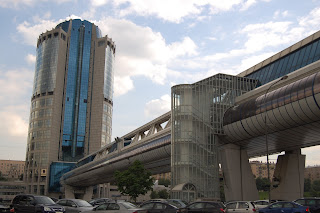Moscow, Russia - Out with drab, old-fashioned sameness and in with slick shiny newness. That's what Moscow is all about.

At the moment, the place is a gigantic construction site. You might say this neighborhood is up-and-coming, with an emphsis on `up'. Skyscrapers of glass and steel tower 20 stories over the rest of the city, shining like beacons to Moscow's wheelers, dealers and fortune seekers.
There are two brand new metro stations - sleek and modern - without any of the brandishments that the older Moscow metro stations are famous for. And a covered pedestrian bridge connects two shiny buildings on opposite sides of the Moscow River. The walkway is lined with shops and cafes, all with huge glass windows overlooking the water. As far as I know, these tall towers are not for residential space, but rather, banks, businesses and all the other offices associated with capitalism.

Meanwhile, if you know where to look, you can find the remains of last century's cutting-edge architecture, less than a mile from here. In the 1920s and 1930s, Constructivist architects were inspired by the revolution to incorporate socialist ideals into their designs. They used sharp angles and geometric forms and lots of glass and steel. While this may sound like the contemporary skyscrapers we see in Moscow-City, its goals were very different.
Many architects concentrated their efforts on communal housing, which was envisioned to be the social unit of the future. The idea was to minimize individual space, encouraging residents to cook and eat together in communal dining areas, to share household chores and childrearing responsibilities, to free women from the daily grind of housework, and - according to architect Moise Ginzburg - to "[create] a new way of life."

Built in the 1920s, Narkomfin was an apartment building for members of the Ministry of Finance. Apparently the block served as inspiration for Le Corbusier, as well as serving as a prototype for apartment blocks around the city. The style may not appeal to everybody, but its place in architectural history is undeniable.



No comments:
Post a Comment